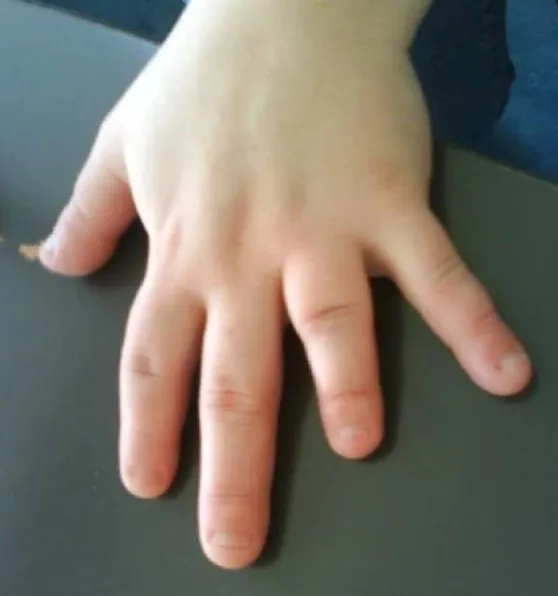- Etiology/Pathophysiology
- A group of rare genetic disorders characterized by end-organ resistance to Parathyroid Hormone (PTH).
- Despite normal or ↑ PTH levels, the body cannot respond appropriately, mimicking hypoparathyroidism.
- PHP Type 1a: The most common and classic form. Caused by a maternally inherited inactivating mutation in the GNAS gene.
- This gene encodes the Gs alpha subunit (Gsα), crucial for PTH receptor signal transduction via cAMP. A defect impairs this pathway.
- Due to genomic imprinting, the Gsα protein is primarily expressed from the maternal allele in the renal tubules. Thus, a maternal mutation leads to PTH resistance in the kidney.
- Pseudopseudohypoparathyroidism (PPHP): Occurs when the same GNAS mutation is inherited from the father. Pts have the physical features of PHP 1a (AHO) but normal biochemistry (normal Ca2+, PO₄³⁻, and PTH) because the maternal GNAS allele in the kidney is unaffected.
- Clinical Features
- Hypocalcemia Symptoms: Due to PTH resistance.
- Numbness, perioral tingling, muscle cramps, and tetany.
- Chvostek sign: Tapping on the facial nerve causes facial muscle contraction.
- Trousseau sign: Carpal spasm induced by inflating a blood pressure cuff.
- Seizures may occur in severe cases.
- Albright Hereditary Osteodystrophy (AHO): A constellation of developmental and skeletal defects seen in PHP 1a.
- Classic Buzzwords: Short stature, round face, obesity.
- Brachydactyly: Shortened 4th and 5th metacarpals/metatarsals, leading to the “knuckle, knuckle, dimple, dimple” sign.

- Subcutaneous ossifications.
- Developmental delay or mild intellectual disability.
- Multi-hormone Resistance: The Gsα protein is used by other hormone receptors, leading to potential resistance to TSH (causing ↑ TSH, hypothyroidism), LH/FSH (hypogonadism), and GHRH.
- Diagnostics
- Labs: The hallmark is the combination of:
- ↓ Serum Calcium (hypocalcemia).
- ↑ Serum Phosphate (hyperphosphatemia).
- ↑ Serum PTH.
- PTH Challenge Test (Ellsworth-Howard test): Historically used. After synthetic PTH infusion:
- In PHP Type 1, there is a blunted urinary cAMP and phosphate excretion response, confirming end-organ resistance.
- Imaging:
- Hand X-rays can confirm shortened 4th and 5th metacarpals.
- Genetic Testing: Confirms mutation in the GNAS gene.
- Differential Diagnosis
- True Hypoparathyroidism: Presents with ↓ Ca2+ and ↑ PO₄³⁻, but PTH levels will be low or absent.
- Vitamin D Deficiency: Presents with hypocalcemia, but will have ↑ PTH and ↓ PO₄³⁻ (due to PTH-mediated phosphate wasting in the setting of a responsive kidney).
- Chronic Kidney Disease: Can cause ↓ Ca2+, ↑ PO₄³⁻, and ↑ PTH (secondary hyperparathyroidism), but renal function (BUN/Cr) will be abnormal.
- Treatment
- Lifelong management focused on maintaining normal calcium and phosphate levels.
- Calcium and activated Vitamin D (e.g., Calcitriol) supplements are the mainstays of Tx.
- Phosphate binders may be used if hyperphosphatemia is severe.
- Regular monitoring of serum/urine calcium, phosphate, and other potentially affected hormones (e.g., TSH) is necessary.
